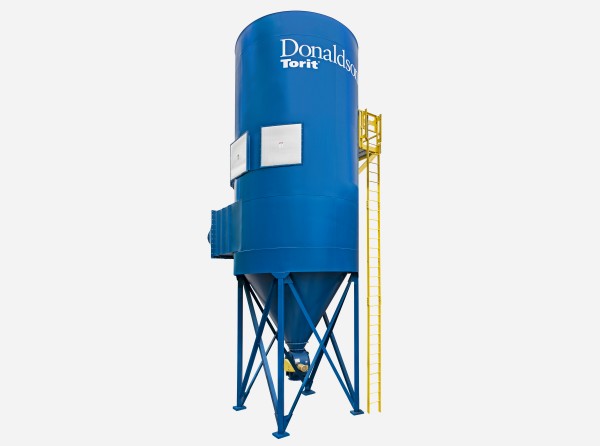When it comes time to purchase or upgrade a baghouse dust collector for your operation, consider the following factors to help ensure you get exactly what you need for your heavy or abrasive dust application.
Dust Profile and Control Requirements
A one-size-fits-all approach with dust collectors rarely meets the specific needs of each customer. In most cases, the application dictates the type of collector to be used. Whether you’re producing sawdust, mineral dust, or welding fumes, it’s important to review your processes and identify the type of dust that’s being created – is it fine or rough; how much is generated per shift; what kind of air volume is associated with the process? Each dust collection situation is unique and applications with heavy and abrasive dusts call for a collector built to handle the work. Round baghouse collectors have proven to be durable, reliable, and effective in harsher production environments. Look for baghouses that are designed to withstand the additional stress of moving larger volumes of air along with tougher dust.
The Donaldson Rugged Pleat (RP) Baghouse collector is manufactured using all-welded 10-gauge steel and heavy-duty ¼-inch (6.4mm) tubesheet construction. The unit includes the exclusive cyclonic SuperSep™ inlet system that pre-separates up to 97% of heavy dust before it even reaches the filters helping reduce wear on the unit and support the life of the filters. The RP’s EvenFlow™ baffles help to reduce turbulence and evenly distribute airflow to the entire filter configuration.
Filter Configuration, Life and Maintenance
Heavy and abrasive dust applications can cause premature wear, tearing and frequent replacement of filters if you don’t have a baghouse collector that is configured to handle this environment. Filter changeouts on a traditional baghouse collector can be messy, labor-intensive and time consuming for maintenance teams and plant personnel. In an effort to limit process downtime, many organizations will conduct filter changeouts afterhours or on weekends.

Most filters in the conventional snap-in felt bag and cage configuration are up to 3.05 meters/10 feet long, adding to the inconvenience and challenge of the job. Before selecting a dust collector, you should make certain to evaluate the costs associated with maintaining its filters. How many filters are in the collector? What is the expected life span of a filter under normal circumstances? How much are replacement filters and are they readily available? Are the filters difficult to handle or hard to replace? How much time and energy will go into replacing spent filters in the collector? While every operation is different, value is universal, so make sure you find a collector that delivers.
The RP utilizes Donaldson’s industry-leading Ultra-Web® Spunbond pleated filters that are only five feet tall and much easier to handle than conventional bags and cages. The optimally sized pleated filters bags are designed to maximize the amount of media per filter while providing increased durability and longer filter life than standard 16-oz. singed polyester felt bags. The result is a collector with up to 44% fewer filters than traditional baghouse collectors which can help reduce change-out times by up to 50%.
Energy Usage
In general, dust collectors use a fair amount of energy on a daily basis. A significant amount of that energy is used to move air. Combine that energy usage with an undersized collector that is overworking to compensate for its lack of performance, and energy costs can quickly become a concern. Due to the physical makeup of the dust, applications that generate heavy and abrasive dust can be more susceptible to inefficiencies than other operations. Maintaining the ideal rate of airflow and ensuring optimum pulse-cleaning energy for your specific application can help you to manage costs. Margins for industrial operations are already slim, so before selecting a dust collector, take a look at your energy requirements. Will a smaller collector operate more efficiently? Will a bigger collector move more air in a short period of time? Will pulse-cleaning help maintain the right airflow volume?
Donaldson’s RP baghouse comes standard with a PD pump that provides energy-efficient pulse air to its PerfectPulse™ cleaning system. The cleaning system utilizes a sensor that verifies pulse nozzle location during cleaning to ensure the cleaning pulse is sent precisely to each filter once every four minutes. The PD pump operates at lower horsepower, providing greater energy efficiency compared to compressed air or reverse air cleaning systems, helping to save you money. Cleaner filters help ensure better airflow, lower pressure drop, and reduced energy usage.
Emissions
Baghouse collectors are often found in some of the harshest work environments, so concerns over emissions are top of mind for facility managers. Since environmental regulations vary from region to region and application to application, it’s important to understand the requirements for your location and work environment. Before selecting a dust collector, you should make certain that it can meet – if not exceed – the emissions standards for your operation.
The RP utilizes Ultra-Web® Spunbond filters with fine fiber technology. The media provides a very fine, continuous fiber of 0.2-0.3 microns in diameter to form a web-like net that traps submicron dust particles – 0.3 microns and larger. By combining Ultra-Web® technology with a sturdy polyester substrate, the pleated bag filters provide 94% fewer emissions than common felt bags.
Remote Dust Collector Monitoring
Adding a remote monitoring service to your dust collector can help improve production uptime, prompt timely maintenance, and reduce operating costs. If you know the cost of your hourly downtime, it is easier to prioritize IoT projects that keep you up and running. If your facility requires a reliable dust collector, calculate your downtime costs and compare them with the costs of subscribing to an IoT-enabled monitoring service. Remote monitoring also makes sense if you are tasked with gathering, tracking, and reporting collector performance data to a local, state, or federal authority having jurisdiction. For example, it can help automate data collection on factors such as differential pressure (dP) and provide up-to-date information during an audit, so the potential for human error associated with manually recording data and visually inspecting equipment is reduced. Remote monitoring can help decrease labor hours and allow maintenance teams to focus on priority projects. Before selecting a dust collector, consider the added value of a remote monitoring service. Advanced notice of a single potential issue could mean the difference between hours or days of downtime.
Donaldson’s iCue™ connected filtration service works with nearly all major brands of dust and fume collectors and allows you to receive alerts in advance of potential maintenance issues that could be time-consuming and costly. The service also tracks the performance metrics that are most critical to your operation. Machine data from each connected device is collected and sent to Donaldson’s secure cloud, where it is transformed into actionable insights that are available on a web-based dashboard that displays the status of all dust collection equipment across your operation, and lets you configure alarm levels and performance notifications.




